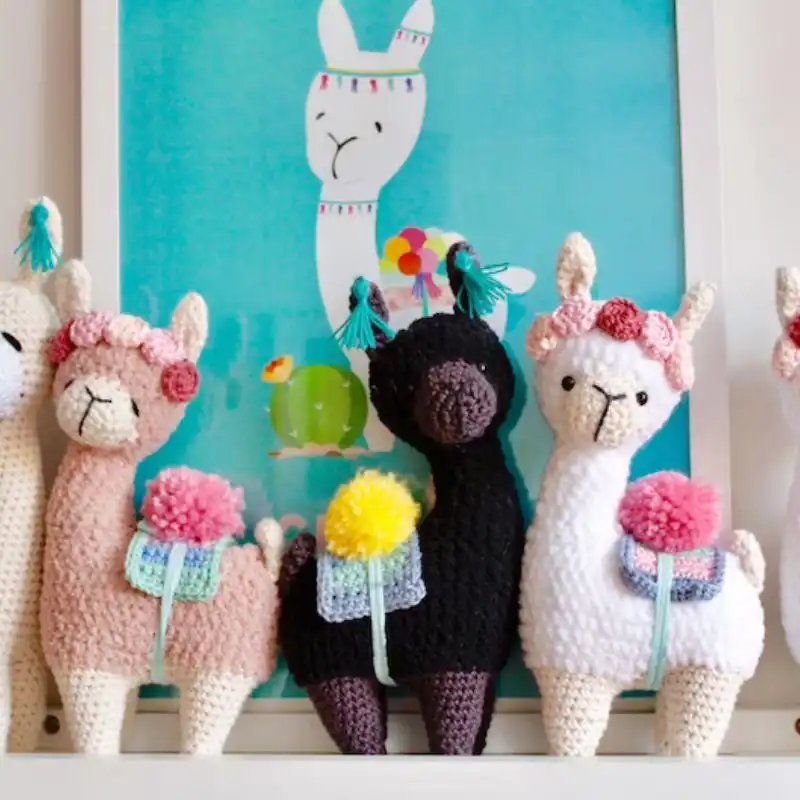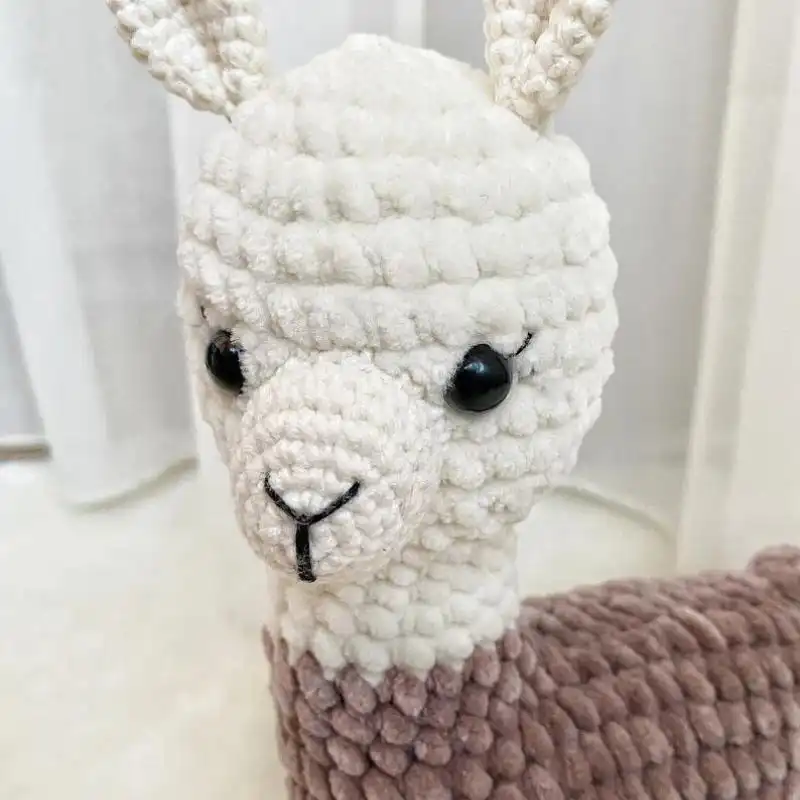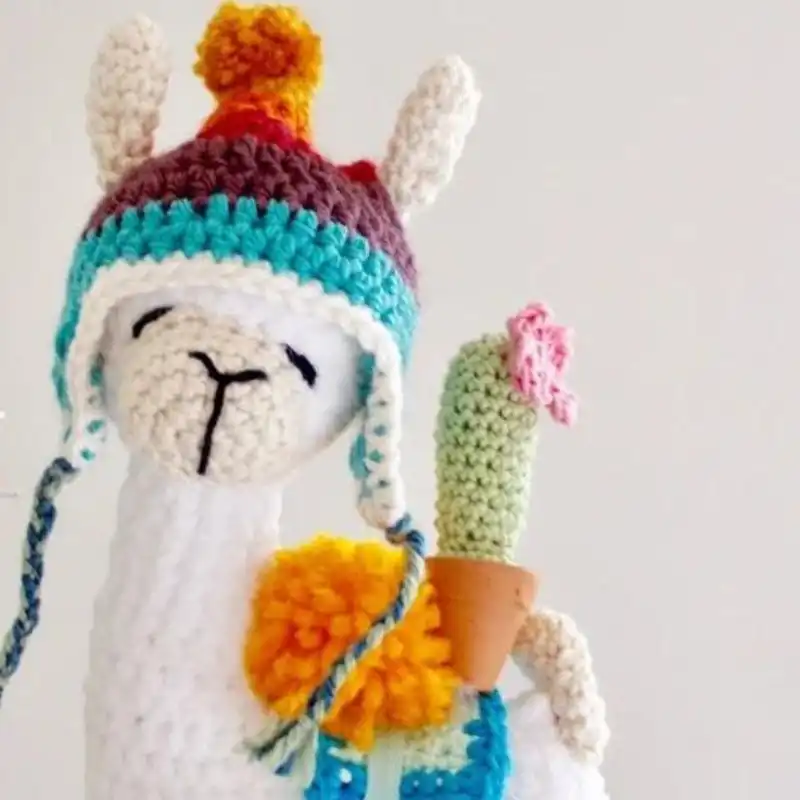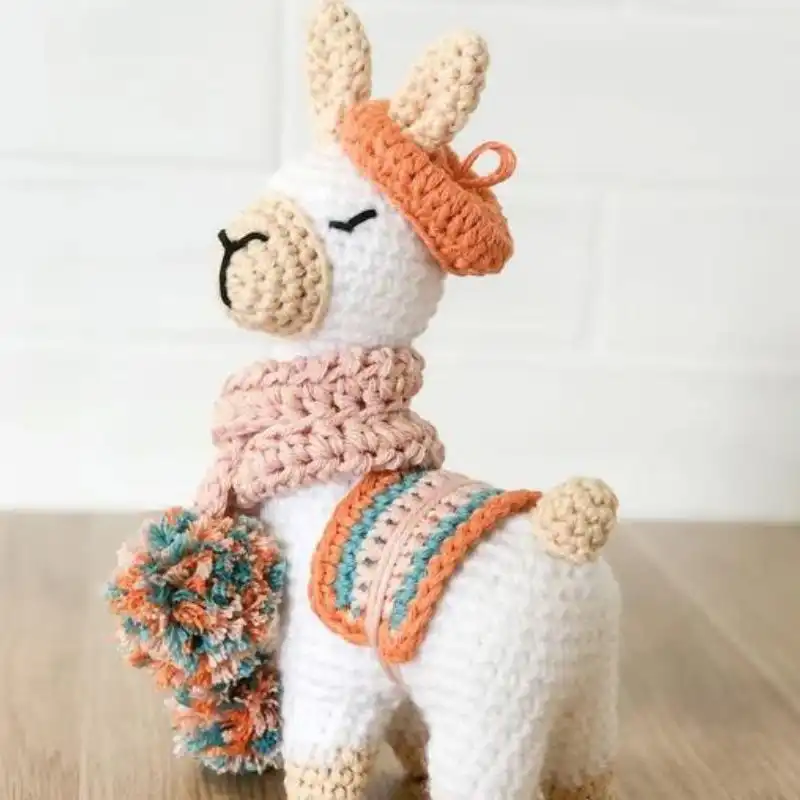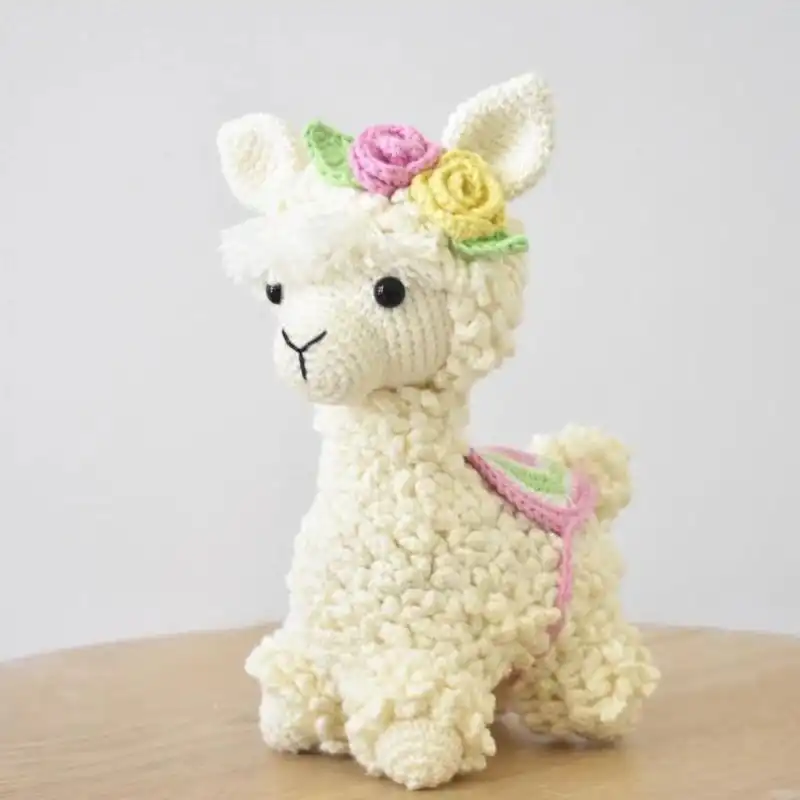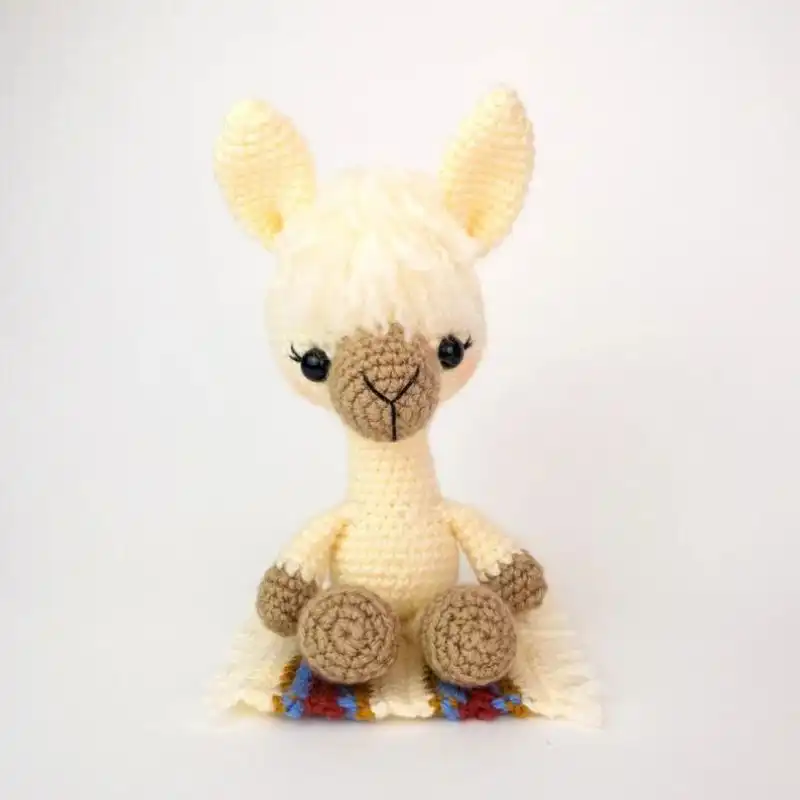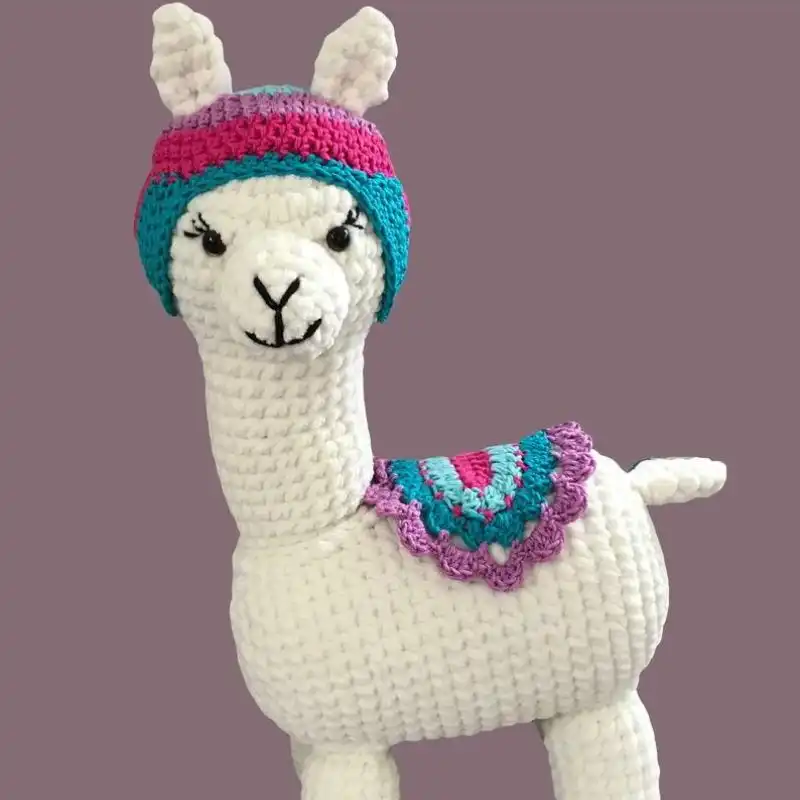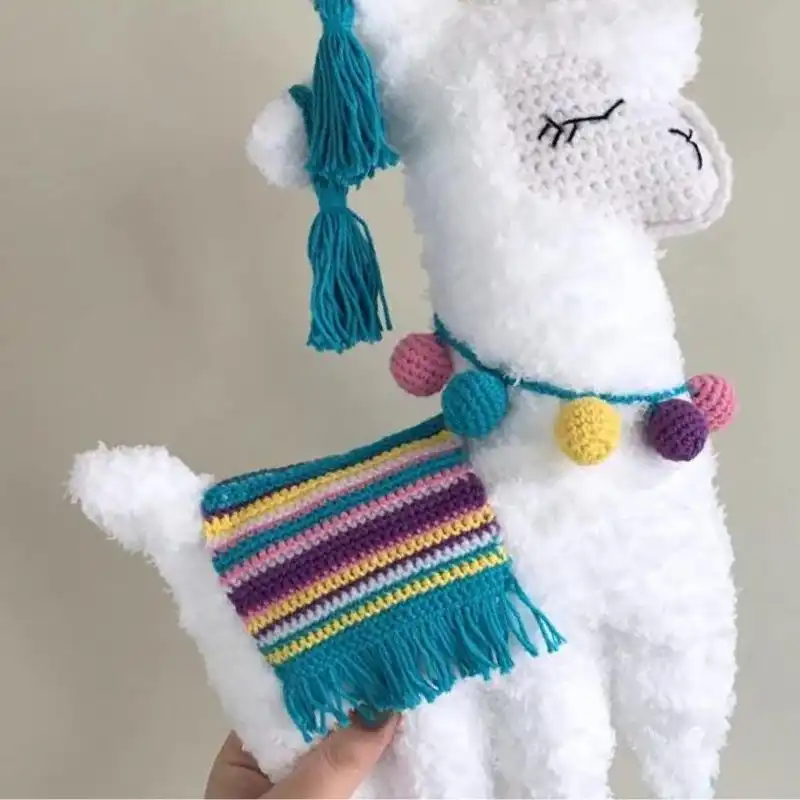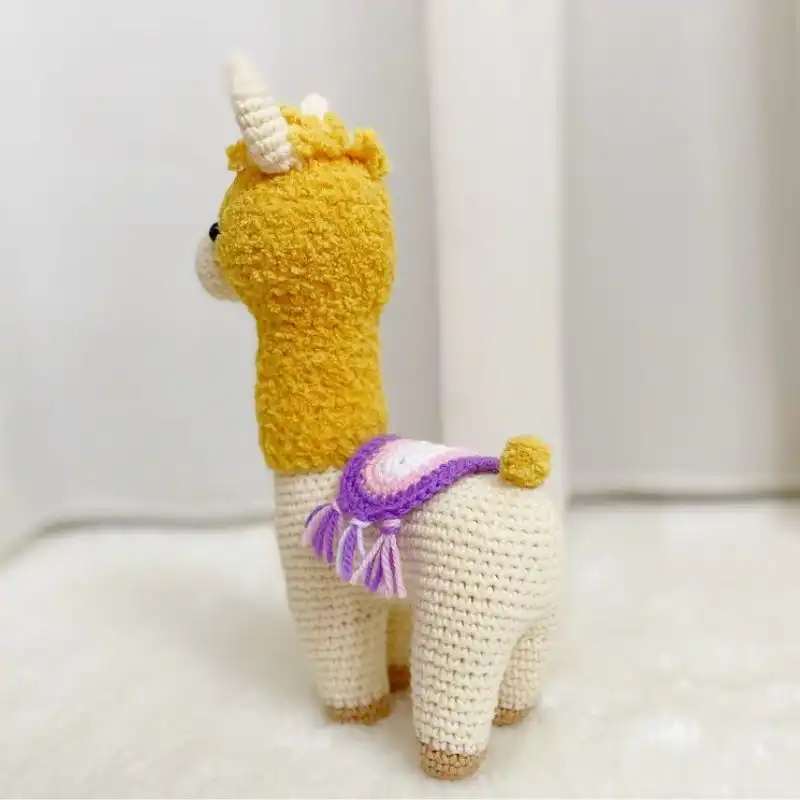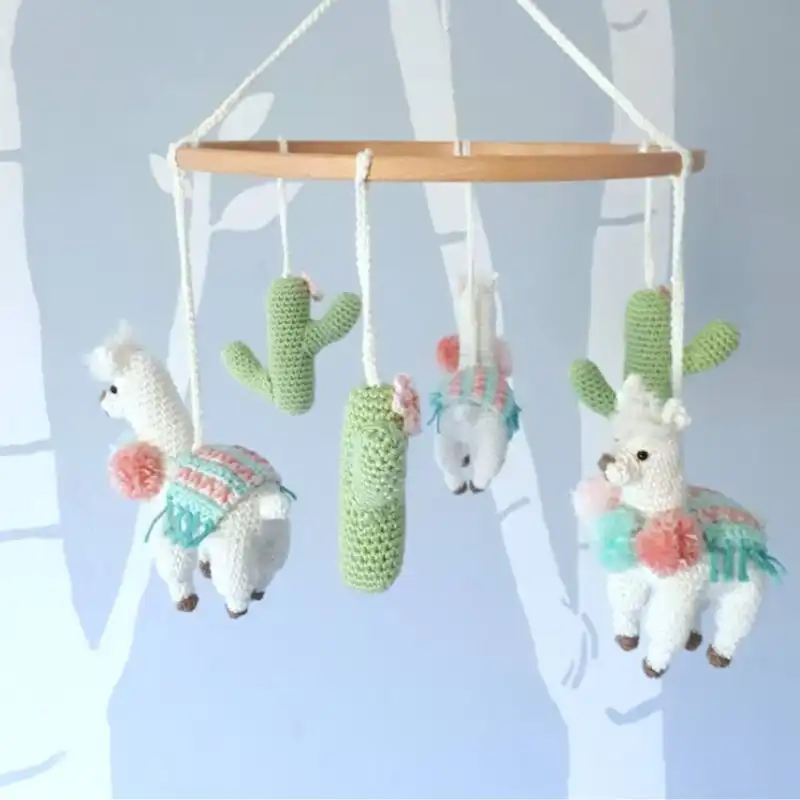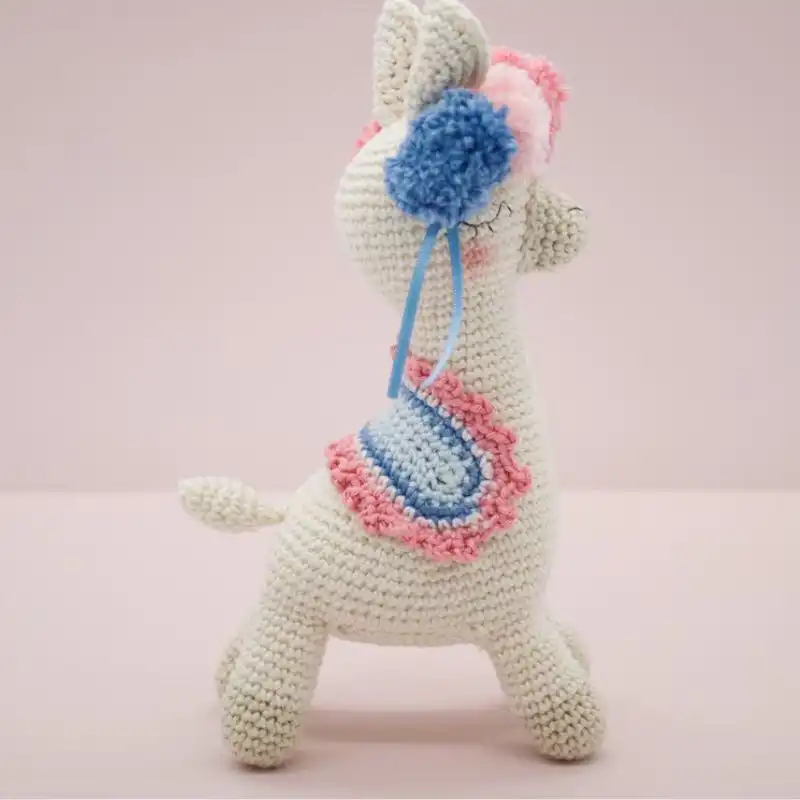
Llamas are the cutest animals ever – so why wouldn’t you want to crochet one?! This can be the perfect gift to someone who you know loves llamas, or alternatively you can crochet a llama as a gift to yourself.
What Is Amigurumi Llama?
Amigurumi Llama refers to a small, handmade crocheted or knitted stuffed toy created in the style of amigurumi, a Japanese craft.
Shaped like a llama, this craft uses colorful yarns and intricate stitching and often includes adorable details like a cute face, fluffy body, and decorative saddle. With the llama’s natural charm and the creativity of amigurumi, these toys are often whimsical, displaying a high level of craftsmanship and artistry.
They serve as great decor, collectibles, or thoughtful handmade gifts for children and adults. Amigurumi Llamas reflect the wonderful blend of traditional crafting techniques and modern design aesthetics.
Is It Worth To Crochet A Llama?
The worthiness of crocheting a llama, much like crocheting an amigurumi octopus or any other craft project, is highly subjective and depends on various factors. Here are some reasons you might find it worth your while:
Tangible Benefits
- Skill Level: If you’re looking to challenge yourself a little, a llama pattern might include various crochet techniques like loop stitches for the fur, color changes for intricate designs, or shaping techniques for the llama’s unique body shape.
- Unique Gift: A handmade crochet llama can make for a delightful and memorable gift for people of all ages, whether they’re fans of llamas or just appreciate handmade crafts.
- Decorative: A crochet llama can be an adorable decoration for your home or workspace, brightening up any area with its whimsy.
- Commercial Potential: If you’re proficient, you might be able to sell your crochet llamas either as ready-made items or as a pattern you’ve designed.
- Educational or Thematic Uses: A crochet llama could be used in educational settings to teach about animals, geography, or even history (llamas were important in ancient Andean cultures).
Intangible Benefits
- Joy of Crafting: Many people find the act of creating to be fulfilling and even therapeutic. The repetitive motions involved in crocheting can be meditative and stress-relieving.
- Creative Outlet: Making a llama allows you to express yourself in color choices, stitch variations, and other customizations. You can make a realistic llama or go for a fantastical, colorful version.
- Sense of Accomplishment: Successfully completing a project can give you a sense of pride and accomplishment, which can benefit your mental well-being.
- Community: Sharing your project with a crafting community, whether online or in person, can offer social benefits and the joy of being part of a shared interest group.
Considerations
- Time: Crafting a crochet llama could be time-consuming, especially if it’s a complicated pattern or if you’re new to crocheting.
- Materials Cost: There’s the expense of the yarn, which varies in price depending on the type and quality, as well as the cost of other materials like stuffing, crochet hooks, and any special features like safety eyes or embellishments.
- Learning Curve: If the pattern requires techniques you’re unfamiliar with, there might be a learning curve, which could be seen either as a challenge or a hurdle, depending on your perspective.
Versatility & Popularity Of Crochet Llama
Crochet Llamas have gained immense popularity due to their versatility and appeal across a broad demographic. Whether as whimsical additions to a child’s toy collection or charming decor for a trendy home, these handmade items balance traditional craft and contemporary design.
They can be customized in size, color, and accessories, making them not just toys but personalized mementos or unique gifts. Additionally, the crochet llama is often used as a learning project for those picking up crocheting, thus boosting their popularity in crafting communities.
The online marketplaces are flooded with many adorable creations, speaking volumes about their widespread appeal. With its versatility and endearing appearance, the crochet llama has genuinely marked a niche in handmade crafts.
RELATED: 41 Free Quick And Easy Crochet Borders [2 Rows Only]
Popular Stitches To Crochet Llama
Crocheting a llama can be an exciting project, allowing you to explore various stitches and techniques. While the exact stitches you’ll use will depend on the pattern you’re following, here are some popular stitches and techniques often found in crochet llama patterns:
Basic Stitches
- Chain Stitch (ch): This foundational stitch is often used to begin a project or to create spaces between stitches.
- Single Crochet (sc): A standard stitch in amigurumi, single crochet provides a tight weave, which is suitable for stuffing without gaps.
- Half Double Crochet (hdc): This stitch is sometimes used for shaping or adding texture.
- Double Crochet (dc): Used less frequently in amigurumi, but it might be used for specific detailing or looser llama parts.
- Slip Stitch (sl st): Typically used for joining rounds or adding edgings.
Increases and Decreases
- Single Crochet Increase (sc inc): This is two single crochet stitches in one stitch, used to widen the shape.
- Single Crochet Decrease (sc dec or sc2tog): This is used to narrow the shape by combining two stitches into one.
Special Stitches for Texture
- Loop Stitch (lp st): This stitch creates loops on the fabric, which can be cut to create a fur-like texture on the llama’s body.
- Bobble Stitch: This stitch creates a ‘bobble’ or bump in the fabric and can be used to add texture or features.
Advanced Techniques
- Magic Ring: A popular method for starting amigurumi, creating a tight circle without a hole in the middle.
- Invisible Decrease (inv dec): A technique for decreasing that creates a less noticeable seam, which is good for a polished look.
- Changing Colors: If your llama has multiple colors, you’ll need to know how to change colors cleanly.
Finishing Techniques
- Fasten Off: After finishing your last stitch, you must fasten off to secure the work.
- Weaving in Ends: Any loose yarn tails should be woven back into the work to secure them.
- Surface Crochet or Embroidery: For adding facial features or additional details, you might use these techniques to add to the surface after the main body is complete.
- Sewing Pieces Together: If your llama has separate pieces like legs, ears, or a tail, you must securely stitch them onto the body.
Essential Tools & Materials
Glossary Of Common Crochet Stitches And Techniques
- Chain Stitch (ch): This is the most basic crochet stitch that all projects start with. It resembles a simple chain, hence the name.
- Slip Stitch (sl st): This is used to join work when working in rounds or to move yarn across stitches.
- Single Crochet (sc): This is the most basic stitch. It creates a tight, dense fabric.
- Half Double Crochet (hdc): This stitch is halfway between a single crochet and a double crochet in height.
- Double Crochet (dc): This is a common stitch for creating a looser, more flexible fabric.
- Treble Crochet (tr): This stitch is taller than the double crochet and is used for looser, more open designs.
- Increase (inc): This technique adds more stitches and width to your project.
- Decrease (dec): This technique is used to eliminate stitches and, therefore, reduce your project’s width.
- Yarn Over (yo): This technique involves draping the yarn over your crochet hook. It’s a step that’s used in various stitches.
- Magic Ring/Magic Circle: This technique is used when starting to crochet in the round. It allows you to pull the hole tight.
- Front Loop Only (FLO) and Back Loop Only (BLO): These techniques create texture in your work. You crochet into only one loop of the stitch instead of both.
- Fasten Off (FO): This is the method of securing the last stitch in your work to ensure it doesn’t unravel.
- Weaving in Ends: This is the method of hiding the loose ends of your yarn within your completed work.
- Gauge is the number of stitches and rows in a specified measurement. It’s important to ensure your finished project is the correct size.
- Blocking: This is the process of wetting or steaming your final project to set the shape and drape.
Understand Crochet Stitches & Patterns
Understanding crochet stitches and patterns can be tricky for beginners, but here are some tips that may help:
- Learn Basic Stitches First: Start by mastering the basic stitches. These stitches form the basis of most patterns.
- Read the Pattern Before You Start: Read the entire pattern before starting. This will give you an overview of what to expect and how the project is organized.
- Learn Abbreviations and Symbols: Most patterns use abbreviations or symbols to represent the stitches. Make sure you understand these before starting. A good pattern will include a key.
- Understand Gauge: Gauge refers to the number of stitches per inch. It is crucial to ensure your finished project is the right size. If the gauge isn’t mentioned, the pattern is likely for a project whose exact size isn’t crucial.
- Get Familiar with Stitch Count: Many patterns will give a stitch count at the end of a row or round. This is a helpful way to ensure you haven’t missed or added any extra stitches.
- Use Stitch Markers: When working in rounds, use a stitch marker to mark the start of a round. This can help keep track of where you are in the pattern.
- Try a Swatch: Before starting the project, make a small swatch to practice stitches and ensure you get the gauge right.
- Use Online Resources: Don’t hesitate to use online tutorials and videos. They can be very helpful in explaining and demonstrating stitches and techniques.
- Ask for Help: If you need help, ask for help. Many online crochet communities are very supportive.
- Be Patient: Understanding crochet stitches and patterns takes time. Practice, and remember that it’s okay to make mistakes. That’s part of the learning process!
Which Yarn Is Best For Crochet Llama?
The yarn you choose for a crochet llama can greatly impact the result, affecting its texture, appearance, and durability. Here are some yarn options that are typically used in amigurumi and their characteristics:
- Acrylic Yarn: This is a popular choice for crochet llamas due to its durability, variety of colors, and ease of care. Acrylic yarn is machine-washable and budget-friendly. However, it’s more soft than some other options.
- Cotton Yarn: Cotton is another common choice for amigurumi. It’s soft, has a nice weight, and is easy to work with. Mercerized cotton has a slight sheen and is more durable than regular cotton.
- Wool Yarn: Wool is warm and soft and has excellent elasticity, making it easy to work with. However, it needs to be hand-washed and may not be suitable for those with wool allergies.
- Alpaca Yarn: This would be a fitting choice for a crochet llama! Alpaca yarn is extremely soft and warm but may be more challenging due to its drape and lack of elasticity. It’s also more expensive and requires careful hand-washing.
- Blended Yarns: Yarns can blend different materials, combining their qualities. For example, a cotton-acrylic blend can be a great choice, offering the softness of cotton and the durability and affordability of acrylic.
When choosing a yarn, you also need to consider the yarn weight. A medium-weight (worsted) yarn is often used for amigurumi, as it creates a tight fabric that holds its shape well and doesn’t let the stuffing show through.
You might want to choose a lighter-weight yarn for a smaller llama, while a chunky or bulky yarn could be used for a larger, cuddlier version.
How Much Yarn Do I Need To Crochet Llama?
The amount of yarn needed to crochet a llama can vary greatly depending on the size of the project and the specific pattern you’re using.
For a small to medium-sized amigurumi llama (around 6 to 8 inches tall), you might need approximately:
- Primary color (for body): 150-200 yards
- Contrast color (for the hair, hooves, and tail): 50-100 yards
- Small amount of black or another color for the face and other details.
You might need significantly more yarn for a larger project or one with more intricate detailing.
Is Crocheting A Llama Beginner-Friendly?
Crocheting a llama can be beginner-friendly, but it largely depends on the complexity of the pattern. Simpler patterns that use basic stitches and techniques, like the single crochet stitch, increase and decrease, and crocheting in the round, can be suitable for beginners.
Making an amigurumi llama involves creating and assembling parts like the body, head, legs, and ears. This might seem challenging to a beginner, but it’s entirely possible with step-by-step instructions and patience.
However, if the pattern involves complex stitches, intricate color changes, or detailed shaping, it might be more suitable for intermediate or advanced crocheters.
If you’re a beginner interested in crocheting a llama, look for patterns labeled as beginner-friendly. You can also watch tutorials or take beginner crochet classes to learn the necessary skills.
How To Crochet A Basic Beginner-Friendly Llama?
Crocheting a llama can be a fun and rewarding project! Below is a basic guide to crochet a beginner-friendly llama. You’ll want to have some experience with basic crochet stitches: single crochet (sc), slip stitch (sl st), and chain (ch).
Materials
- Worsted weight yarn in the main color for the body (approximately 150-200 yards)
- Worsted weight yarn in a secondary color for the blanket and accessories (approximately 50 yards)
- Small amount of black yarn or embroidery thread for facial features
- Crochet hook size US H/5mm
- Safety eyes or buttons (optional)
- Polyfill stuffing
- Tapestry needle
- Scissors
- Stitch marker or scrap yarn to mark rounds
Abbreviations
- sc: Single Crochet
- ch: Chain
- sl st: Slip Stitch
- inc: Increase (2 sc in the same stitch)
- dec: Decrease (sc 2 stitches together)
Body (Make 1)
- Round 1: Start with a magic ring, and make 6 sc in the ring.
- Round 2: inc in each stitch around (12 sc).
- Round 3: [sc, inc] repeat around (18 sc).
- Round 4: [2 sc, inc] repeat around (24 sc).
- Rounds 5-10: sc in each stitch around (24 sc).
- Round 11: [2 sc, dec] repeat around (18 sc).
- Round 12: [sc, dec] repeat around (12 sc).
- Round 13: dec around (6 sc).
Fasten off, leaving a long tail. Stuff firmly with polyfill.
Legs (Make 4)
- Round 1: Start with a magic ring, and make 6 sc in the ring.
- Rounds 2-6: sc in each stitch around (6 sc).
Fasten off, leaving a long tail. Stuff lightly.
Ears (Make 2)
- Row 1: ch 5.
- Row 2: Starting in the second chain from the hook, make 4 sc.
- Row 3: ch 1, turn, 4 sc.
- Row 4: ch 1, turn, dec, dec (2 sc).
Fasten off, leaving a long tail.
Assembly
- Attach Legs: Sew the legs onto the bottom of the body.
- Attach Ears: Sew the ears onto the top sides of the body.
- Face: Use black yarn to embroider eyes and a mouth or attach safety eyes.
Blanket
- Row 1: With the secondary color, ch 20.
- Row 2-4: Turn, starting in the second chain from the hook, and make 19 sc across.
- Fasten off and weave in ends.
Final Assembly
- Attach Blanket: Lay the blanket over the llama’s back and tack it down with a few stitches at the corners.
Different Types Of Llama Patterns
1. Llama Crochet Pattern
So, immediately we have swayed from the llama theme – but we do have very good reason. This pattern is just ADORABLE – and it will let you make your own really sweet cuddly llama. This would make the perfect gift for anyone who loves alpacas – or you could just give yourself this gift.
Photo Disclaimer – Images used in this article are owned by the respective individuals, artists, or other parties who post on their private social media accounts.
These images only serve for inspiration and cannot be copied (images or the designs) for personal use. See Footer for more details. See here for more details.
Although we have immediately strayed from the llama theme, we could not ignore this top-rated crochet pattern on Etsy – it is just so cute!
Suggested Yarn: Worsted weight acrylic yarn
Difficulty Level: Beginner
Yarn Weight: Medium (4)
Crochet Hook Size: 4 mm (G-6)
2. Hatching Llama
Okay, you will be pleased to know that we are officially back on the llama crochet pattern trail. And, this llama is especially funky! Called the ‘hatching llama’, this llama is in its very own hatching rainbow egg – or pouch. This is super unique and even more adorable – and we already know that you will not have anything like this in your stuffed animals collection.
Suggested Yarn: DK weight acrylic yarn
Difficulty Level: Intermediate
Yarn Weight: Light (3)
Crochet Hook Size: 3.5 mm (E-4)
3. Pacha Llama
This llama crochet pattern is a take on a much more classic and traditional looking llama – it is the authentic pacha design that gives this llama that well-loved look. This llama looks more than ready for its own expedition, and would be the perfect gift for someone who has been to or is preparing to go travelling – as this llama looks more than ready to take on an adventure.
Suggested Yarn: Bulky weight acrylic yarn
Difficulty Level: Intermediate
Yarn Weight: Bulky (5)
Crochet Hook Size: 6 mm (J-10)
4. Llama Friends
These llamas come as a pair that cannot be separated – they are the best of friends, and they are so cute you would not want to separate them. The girl llama is adorned with flowers around her neck, and the boy llama is adorned with blue tassels around its neck. They are the cutest pair and they are too adorable to not love!
Suggested Yarn: Worsted weight acrylic yarn
Difficulty Level: Beginner
Yarn Weight: Medium (4)
Crochet Hook Size: 4.5 mm (7)
5. Llama Stuffed Animal
Here we have llamas that are much more authentic looking, they have a much more neutral color palette going on – and these ones are just super cute. These llamas would be the perfect present for a new born baby, due to their cute faces and their delicate features. The softness of the crochet patterns make them perfect for newborn babies – we just love them and think that they would be the perfect gift. Why not start the llama love really young?!
Suggested Yarn: Worsted weight acrylic yarn
Difficulty Level: Intermediate
Yarn Weight: Medium (4)
Crochet Hook Size: 4 mm (G-6)
6. Pacha And Hipster Llama
We have gone back to the classic pacha llama here, but this crochet pattern comes with an especially hip twist… or should we say hipSTER twist. This classic llama is paired with a hipster llama so you really get that perfect modern and traditional blend. The pacha llama is adorned with the classic headwear, and this one also has a mini cactus complimenting it too. The hipster llama has a cute pastel hue color scheme and some spectacles too!
Suggested Yarn: DK weight acrylic yarn
Difficulty Level: Intermediate
Yarn Weight: Light (3)
Crochet Hook Size: Light (3)
7. Louisa Llama
Louisa llama is the most stylish llama of them all… have you ever seen a llama wearing a beret? No? Well, now you have Louisa – who is the sweetest beret-wearing llama there is. Not only is Louisa wearing a beret, she is wearing a pom pom scarf which just adds that extra bit of sass to this stylish llama.
Suggested Yarn: Bulky weight acrylic yarn
Difficulty Level: Intermediate
Yarn Weight: Bulky (5)
Crochet Hook Size: 6 mm (J-10)
8. Miss Aviana The Alpaca
Are you looking to crochet a super cute and super girly alpaca? Well, look no further than little Miss Aviana the alpaca. We know that this strays away from the theme again… but she is too adorable to not include. Miss Aviana is adorned with pinks and floral embellishments which make her look super cute. She is just a crocheting dream!
Suggested Yarn: Worsted weight acrylic yarn
Difficulty Level: Intermediate
Yarn Weight: Medium (4)
Crochet Hook Size: 4.5 mm (7)
9. Amigurumi Llama
Back to the llamas and sticking with the theme – here we have another set of llama friends. These are pretty big in size, and they are just adorable. The one llama has a blue scarf and the other llama has a pink scarf and also a sweet pink flower. Cute couple or the best of friends? This is totally at your crocheting discretion.
Suggested Yarn: Worsted weight acrylic yarn
Difficulty Level: Beginner
Yarn Weight: Medium (4)
Crochet Hook Size: 4.0 mm
10. Lucy The Llama
Another adorable llama for you to obsess over and appreciate – Lucy the llama is super small and such a sweetheart. This little llama would make the perfect gift for a small child, or for anyone who just loves llamas in general.
Suggested Yarn: Worsted weight acrylic yarn
Difficulty Level: Intermediate
Yarn Weight: Medium (4)
Crochet Hook Size: 4 mm (G-6)
11. Llama Red Pajama
Now, here we have a llama that is a lot more partial to a party, and that is a lot more of a funky looking llama. The red heart llama red pajama is so sweet and will be really fun to crochet. This llama is wearing a red pajama and this is what makes this llama that bit more funky.
Suggested Yarn: Worsted weight acrylic yarn
Difficulty Level: Intermediate
Yarn Weight: Medium (4)
Crochet Hook Size: 4 mm (G-6)
12. Llama Amigurumi Plush
This llama is so adorable and there is nothing not to love about it. The simplicity of the design is really effective and it just makes the llama the best companion. It is so cute and adorable, it would be rude not to be obsessed with this llama.
Suggested Yarn: DK weight acrylic yarn
Difficulty Level: Beginner
Yarn Weight: Light (3)
Crochet Hook Size: 3.5 mm (E-4)
13. Luisa – das Drama-Lama
Here we have another llama that ventures into a funky town. This llama is so soft and fluffy, and it comes adorned with its own bright personality for sure!. All in all, this llama is pretty unique and it is safe to say that no one will have a llama toy quite like this.
Suggested Yarn: Bulky weight acrylic yarn
Difficulty Level: Intermediate
Yarn Weight: Bulky (5)
Crochet Hook Size: 6 mm (J-10)
14. Ragdoll Llama
This llama crochet pattern really goes back to that authentic and traditional crochet style. This crochet pattern will allow you to make llamas which are colorful but very true to a ‘real’ Peruvian llama. You could either make a llama with dark fur and vibrant accessories or you could make a llama with white fur and more pastel accessories. Or, you could even make both! The choice is yours.
Suggested Yarn: Worsted weight acrylic yarn
Difficulty Level: Intermediate
Yarn Weight: Medium (4)
Crochet Hook Size: 4.5 mm (7)
15. Amigurumi alpaca pattern
Another llama which is visually very authentic in terms of appearance, although this one has a lot less fur detailing, this is a very clean cut llama that does have that traditional feel. This is all to do with the simplicity behind the design. However, this llama is complimented by a pastel shawl which makes it look that extra bit sweeter.
16. Boho Llama
This is much more of a two dimensional llama in that this is a flat crochet piece. But, that does not make this crochet pattern any less cuter. This is a really unique and decorative crochet pattern, that is completely unique to anything that you might come across on the high street. This llama is just adorable and will add a sense of personality and flair to any room.
Suggested Yarn: Worsted weight acrylic yarn
Difficulty Level: Beginner
Yarn Weight: Medium (4)
Crochet Hook Size: 4 mm (G-6)
17. Llama Baby Mobile
We can guarantee that this is the perfect gift to a newborn baby as this is a super sweet and unique gift. There are a wide range of baby mobiles on the market, but we can guarantee that there are no baby mobiles quite like this. This is a really unique baby mobile and it is the sweetest thing. We are pretty certain that the newborn’s parents will adore this too!
Suggested Yarn: Worsted weight acrylic yarn
Difficulty Level: Intermediate
Yarn Weight: Medium (4)
Crochet Hook Size: 4.5 mm (7)
18. Lara the llama
Oh, the lara the llama is super simple but it is just adorable. This llama crochet pattern is much more of a hug-friendly toy and this would be perfect for any toddler who loves a hug. This lara the llama will be the perfect companion for any toddler and its facial features are just adorable.
Suggested Yarn: Worsted weight acrylic yarn
Difficulty Level: Intermediate
Yarn Weight: Medium (4)
Crochet Hook Size: 4 mm (G-6)
19. Llama Planter
Last but not least, we have that perfect gift for anyone who is a plant lover as well as a llama lover. Didn’t think you could combine the two? Well, think again! This llama planter is so adorable and your favorite plant will be able to sit quite comfortably in this. It is so unique and so funky, you will be totally obsessed with this. The colorful pom poms adorning the planted give this llama planter that extra bit of personality.
Suggested Yarn: Worsted weight acrylic yarn
Difficulty Level: Intermediate
Yarn Weight: Medium (4)
Crochet Hook Size: 4.5 mm (7))
Do’s & Don’ts For A Safe Llama
If you’re considering owning, interacting with, or caring for a llama, it’s essential to be aware of some key do’s and don’ts to ensure your safety and the animal’s well-being. Here are some guidelines:
Do’s
- Research Beforehand: Learn about llama behavior, needs, and signs of distress.
- Approach Slowly and Calmly: Quick movements and loud noises can startle llamas.
- Use Open Hands: When approaching, it’s recommended to use an open hand and allow the llama to sniff you first.
- Feed Appropriately: Make sure to feed them the right kind of food and in the appropriate manner. Always feed a llama at ground level to discourage spitting.
- Regular Vet Visits: Just like any other pet, llamas require regular check-ups from a vet.
- Exercise and Socialize: Llamas need plenty of exercise and social interaction with both humans and other llamas.
- Clean Living Spaces: Make sure to keep their living spaces clean to prevent disease.
- Secure Fencing: Use fencing to create a secure environment. Make sure it’s high enough to prevent them from jumping over.
- Handle Feet and Ears: Regularly check and clean their feet and ears, as these are common areas for infection.
- Follow Local Laws and Regulations: Make sure you are allowed to own a llama in your area and obtain any necessary permits.
Don’ts
- Don’t Make Sudden Movements or Noises: This can scare the llama and make it more challenging to interact with them.
- Don’t Feed Random Foods: Llamas have a specific diet, and certain foods can be harmful.
- Don’t Ignore Signs of Stress or Illness: Llamas can’t tell you when something is wrong, so it’s essential to know the signs and seek vet assistance immediately if needed.
- Don’t Let Children or Pets Unsupervised: Always supervise interactions between llamas and children or other animals.
- Don’t Use Barbed Wire: This can cause serious injury to a llama.
- Don’t Tie Them Up For Long Periods: Llamas should be kept from being tied or constrained for extended periods.
- Don’t Forget About Dental Care: Dental problems can lead to eating disorders and other health issues in llamas.
- Don’t Isolate Them: Llamas are social animals and can become stressed or aggressive if kept alone.
- Don’t Neglect Training: Basic training for halter wearing or leading tasks is essential for a well-behaved llama.
- Don’t Mistreat or Abuse: Llamas should be treated with kindness and respect like all animals.
Tips & Tricks To Avoid Crochet Mistakes For A Perfect Crochet Llama
Crocheting a llama can be a fun and rewarding project. Here are some tips and tricks to help avoid common mistakes:
How To Block The Crochet Llama?
Blocking is wetting or steaming your crochet work to set the shape and drape. However, blocking is generally unnecessary for most amigurumi projects, including a crochet llama, because these projects are stuffed, and the stuffing helps them hold their shape.
However, suppose you find that certain parts of your crochet llama (like the ears or other accessories) aren’t flat or have curled edges. In that case, you can block those individual pieces before attaching them to your llama. Here’s a primary method for wet blocking:
- Wash or Wet Your Crochet: Hand wash your piece gently in lukewarm water. You can use a bit of mild soap if you wish. Alternatively, spray the piece with a spray bottle until thoroughly damp.
- Remove Excess Water: Do not wring out your crochet work, as it may distort the stitches. Instead, gently press out the excess water. You can also roll the piece up in a towel and press on it to absorb more water.
- Shape and Pin: Lay the piece flat on a blocking board or a towel. Suppose you don’t have a blocking board, any flat surface that can withstand being pinned into and getting wet will work. Shape the piece to the desired dimensions and then pin it in place. Make sure to use rust-proof pins to prevent staining.
- Let It Dry: Allow the piece to air dry completely. This can take anywhere from a few hours to a few days, depending on the thickness of the yarn and the humidity in your area.
- Remove the Pins: Once completely dry, remove the pins. Your crochet piece should now hold the shape you pinned it into.
Suggestions To Add A Personal Touch To Crochet Llama
Adding a personal touch to your crochet llama can make it unique and extra special. Here are a few ways to do so:
- Color Selection: Choose colors that have special meaning, match a certain room decor, or are simply favorites. You can also experiment with variegated yarn for a multi-colored effect.
- Embroidery: Add embroidered details like initials, a special date, or a simple design. This could be on the llama’s body or a tag attached to it.
- Accessories: Add a personal touch with accessories. You could crochet a little hat or scarf, a bandana with a unique pattern, or even a tiny saddle. If it’s a gift for a certain occasion, themed accessories like a birthday hat or a Christmas scarf can be added.
- Facial Features: Experiment with the placement and style of eyes, nose, and mouth to give your llama different expressions. Safety eyes, embroidered eyes, or even buttons can be used.
- Fringe or Hair: Vary the length, fullness, and color of the fringe or hair on your llama to create different looks.
- Texture: Use different stitches to create interesting textures on your llama. For example, a bobble stitch could create a fluffy texture.
- Size: Change the size of your llama by using different yarn weights and hook sizes. A tiny, pocket-sized llama could be a cute keychain, while a large llama can serve as a cuddly pillow.
- Personal Tags: You could add a small fabric or crocheted tag with a special message or the recipient’s name.
- Different Yarns: Use a different type of yarn for an interesting texture. For example, fuzzy yarn can give your llama a soft and fluffy coat.
RELATED: 75 Free Lovely Crochet Sweater Patterns (With Pictures)
Can We Use Crochet Llama As Home Decor?
A crochet llama can make a delightful piece of home decor! The charm of amigurumi, including crochet llamas, lends a cozy and whimsical touch to any room. Here are a few ways you could use a crochet llama for home decoration:
- Shelf or Mantel Display: Place your crochet llama on a shelf, bookcase, or mantelpiece. It can add a touch of color and whimsy to your decor.
- Children’s Room: A crochet llama can be a charming addition to a nursery or child’s room. It can be used as a decorative piece on a shelf, a playful toy, or a cuddly pillow.
- Centerpiece: For a fun and unique table centerpiece, group a few crochet llamas together. This could be especially fun for a themed party or special event.
- Holiday Decor: Decorate your crochet llama for holidays. Add a Santa hat for Christmas, a witch’s hat for Halloween, or bunny ears for Easter.
- Plants Companion: Place your crochet llama next to indoor plants or use it as a larger decorative arrangement.
- Key Holder: Attach a ring to a small crochet llama to create a keychain. The door can hang for a cute and functional decor piece.
- Wall Decoration: Adding a loop or string, a crochet llama can be hung on the wall, individually or as part of a collage or grouping other items.
- Door Stopper: A larger, weighted crochet llama can be a creative door stopper.
Wash & Care Instructions
Proper care is crucial to maintaining the look and feel of your crochet llama. Here are some general wash and care instructions:
- Check Your Yarn Labels: Yarn labels usually provide essential information about washing and drying. Be sure to follow the manufacturer’s recommendations.
- Hand Washing: Most handmade crochet items do best with hand washing. Use lukewarm water and a mild detergent or soap. Avoid harsh chemicals that can damage the yarn. Gently agitate the item in the water to clean it, but avoid wringing or twisting, which can stretch and distort the stitches.
- Rinsing: Rinse thoroughly but gently in clean, lukewarm water until all the soap is gone.
- Drying: Gently squeeze out excess water (do not wring), then lay it flat on a clean, dry towel. Roll the towel up with the llama inside to absorb more water. Afterward, reshape the llama as necessary and leave it flat to dry completely. Avoid direct sunlight, which can cause colors to fade.
- Machine Washing: If your yarn label allows machine washing, place the crochet llama in a mesh laundry bag to protect it from snagging or tangling. Use a gentle cycle with cold water and mild detergent.
- Storing: Once clean and completely dry, store your crochet llama in a cool, dry place away from direct sunlight. If storing long term, consider a breathable fabric bag to protect from dust while allowing airflow.
- Professional Cleaning: If your crochet llama is made of a particularly delicate or specialty yarn, you might consider professional cleaning.
- Repairing: With use, the crochet llama might need some repairs. Keep leftover yarn from the project for this purpose.
A Quick Recap
Creating a crochet llama is a delightful project that’s potentially beginner-friendly, depending on the complexity of the pattern. Key tools include yarn, crochet hooks, stuffing, stitch markers, and a yarn needle.
Understanding common crochet stitches and pattern instructions is crucial to perfect results. The choice of yarn influences the end product, with acrylic yarn being versatile and user-friendly.
Adding personal touches, such as color choices, accessories, or embroidery, makes each llama unique. Although typically not necessary for amigurumi, blocking can help shape individual components.
Lastly, proper washing and storage ensure the longevity of your handcrafted llama.
Frequently Asked Questions
What’s The Best Way To Get Started In Crochet?
A. Do you want to get started in crocheting, but you’re not too sure where to begin? Well, these designs might seem intimidating to you but practice really does make perfect here. It is so important that you dedicate some time to hooking yourself up with the basics and then you have a lot of crochet patterns at your fingertips to test out.
What Is The Best Way To Do A Double Crochet?
A. First of all, you need to yarn over, then insert the hook into the third loop from your hook. Yarn over and then pull through so that you now have three loops on your hook. Yarn over and then pull through two loops, so that two loops will be left on your hook. Yarn over and pull through the last two loops so that you can complete your very first double crochet. Now you must not forget to tie up your loose ends!
How Do You Make A Chain Out Of Crochet Yarn?
A. To crochet a chain out of yarn, first of all you need to make a slip knot around the crochet hook. Next, wrap the yarn once around the crochet hook above the slip knot – finally use the hook to pull the yarn through the slip knot.
What Type Of Yarn Should I Use For My Llama Crochet Project?
Choosing the right yarn is essential to get the desired look and feel for your crocheted llama. Generally, a medium-weight or worsted yarn is a good choice for beginners. If you’re looking to make a more fluffy and fuzzy llama, consider using bouclé yarn or a specialty “furry” yarn for specific areas like the mane and tail. Always make sure to read the recommendations given in your chosen llama crochet pattern, as different patterns may require different yarn types, weights, and amounts.
How Difficult Is It To Crochet A Llama, And What Skills Do I Need?
The difficulty level can vary depending on the pattern you choose. Basic llama crochet patterns may only require knowledge of fundamental stitches like single crochet, double crochet, and slip stitch, and are often suitable for beginners. More advanced patterns might incorporate complex stitches and techniques such as bobble stitch for texture or colorwork for pattern detailing.
- 30 Polo Sweater Knitting Patterns To Keep You Stylish On Every Occasion - January 1, 2024
- 21 Baby Blanket Knitting Kits To Wrap Bundle Of Joy With Love - January 1, 2024
- 15 Cashmere Knitting Kits For Fashionable Knits To Embrace Comfort And Style - January 1, 2024




